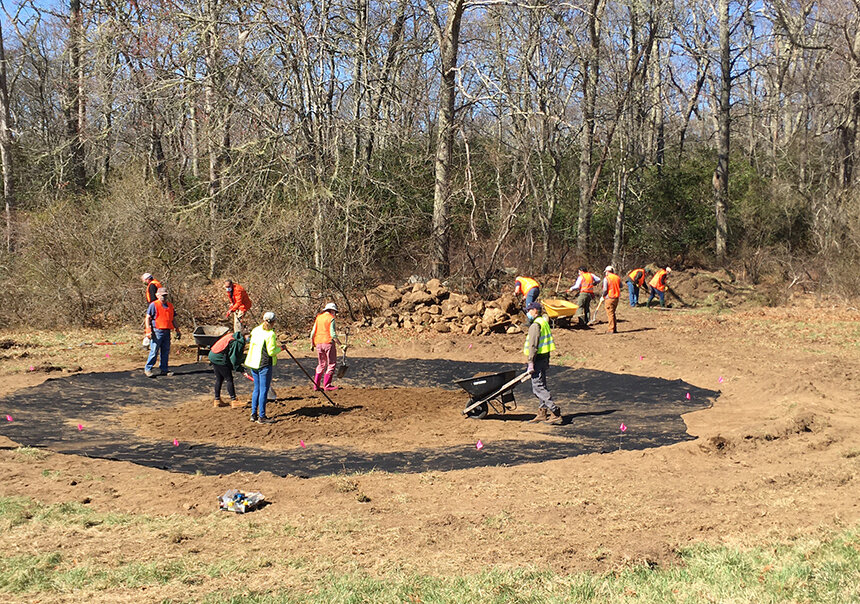Volunteers Build New Breeding Ponds for Rare Frog
By TODD McLEISH/ecoRI News contributor
Biologists,
with volunteer help, are building two breeding ponds for the eastern spadefoot
on property owned by the South Kingstown Land Trust. (Todd McLeish/for ecoRI
News)
In a meadow in this seaside town, dozens of volunteers joined
biologists and a heavy-equipment operator for three days in early April to
build two shallow ponds designed for the breeding specifications of Rhode
Island’s rarest frog, the eastern spadefoot.
During
construction, an excavator dug out the ponds, then volunteers smoothed the soil
into a shallow depression that would hold about 10 inches of water. They then
placed a liner on the depression, covered it with soil, and seeded the area
with annual rye grass and wheat straw mulch for erosion control.
“Eastern
spadefoots use boring wetlands, just temporary wetlands with no special
vegetation,” said Tom Biebighauser, a wetland ecologist from Kentucky who
travels the country helping conservation groups build wetlands for rare
amphibians. “They’ll be dry most of the year, but after a thunderstorm they’ll
fill up, and if it’s warm enough, it will trigger the breeding of the
spadefoots.”
The
project is a follow-up to a similar effort in
2019 in Richmond, near the site of what was then the state’s only known spadefoot
population. Two more populations have been discovered since then, and some of
the offspring of the known populations are expected to be brought to the newly
built ponds to establish a fourth population.
“It sounds crazy to build a wetland for a frog that most people have never seen, but how often do you get to help an endangered species?” Biebighauser said. “We know what to do, we have the land and the heavy equipment. We’re building a wetland for eastern spadefoots that will last forever.”
Eastern spadefoots — sometimes called spadefoot toads although they are actually frogs — spend most of their lives below ground and only come out at night. With bulging eyes and a spade-shaped protrusion on their feet for digging, they are most noticeable when they are calling from their breeding pools in early summer after having emerged from their woodland burrows to mate and lay eggs.
“It’s
not out of the question that spadefoot toads are already here and we don’t know
about it,” said David Gregg, director of the Rhode Island Natural History
Survey, speaking of the South Kingstown site. 
Eastern spadefoot frogs, among the rarest amphibians in the Northeast,
range in size from 1.75 inches to 3 inches in body length. (istock)
But there are no breeding pools
here, so how would we know if they were here or not. One could just hop by, but
it’s more likely that we’ll take some baby toads from one of the other places
and put them here.”
The
construction project is led by the state’s leading herpetologists — Nancy
Karraker at the University of Rhode Island, Scott Buchanan at the Rhode Island
Department of Environmental Management, and Lou Perrotti at Roger Williams Park
Zoo. But its success depends largely on the guidance of Biebighauser, who has
been building and restoring wetlands for wildlife since 1979.
A
retired biologist for the U.S. Forest Service, Biebighauser saw his first
eastern spadefoot in 1988 after being transferred from Minnesota to Kentucky,
where the frog was one of the rarest species in the Daniel Boone National
Forest.
“No
one knew how to improve habitat for them, so I built wetlands on mountain
ridges and discovered that eastern spadefoots used them for breeding,” he said.
For the past 10 years he has built eastern spadefoot breeding pools on Cape Cod every year for Massachusetts Audubon. During one of his visits to the area, he scouted locations for similar pools in Rhode Island after an analysis had been conducted of the state’s soil types and the habitat the frogs require. The South Kingstown site, on property owned by the South Kingstown Land Trust, was identified as an ideal candidate.
 |
| Spadefoot frogs have stout bodies and their hind feet are large and contain hard tissue that allows them to function as ‘spades’ for digging in loose soils. (Nancy Karraker) |
The
frogs only use their breeding pools for a day or two each year. Three weeks
later, their eggs will have hatched and their tadpoles transformed into tiny
froglets called metamorphs that will leave the pond and hop into the forest.
They will remain there for the next three to five years until they are ready to
breed.
The
ponds must be shallow enough to dry up soon after the metamorphs leave so no
other frog species — which might eat the spadefoot tadpoles — could use it for
breeding. The eggs and tadpoles of all other frogs in the area require a longer
period in the water to successfully breed.
“When
I first started, only half of the pools we built were successful,” Biebighauser
said. “Many of them would dry up too quickly. But over the years we determined
why wetlands don’t function as planned. We started using aquatic-safe,
fish-grade liners in 1988, and our success rate has been pretty high since
then.”
After
this year’s breeding season, Roger Williams Park Zoo will likely raise some of
the tadpoles until they transform into metamorphs, a common process called
headstarting.
“So
many toads die of natural causes that headstarting them — taking them out of
the line of fire for a little while — produces more toads,” Gregg said.
If
funding can be acquired, additional breeding pools for eastern spadefoots could
be built in Barrington next year.
“The
shallow water wetlands that eastern spadefoots need to breed have been drained
and filled across Rhode Island,” Biebighauser said. “We’re working to bring
them back. And we know we’ll be successful.”
Rhode
Island resident and author Todd McLeish runs a wildlife blog.
